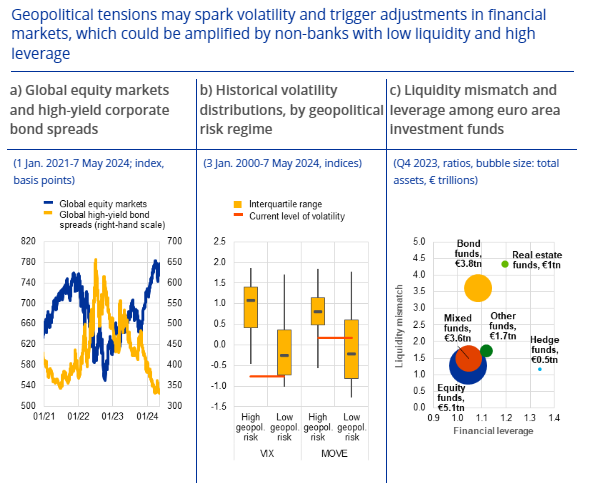The European Central Bank (ECB) released the May 2024 financial stability report, noting that geopolitical tensions may spark volatility and trigger adjustments in financial markets, which could be amplified by non-banks with low liquidity and high leverage. In addition bank funding costs have continued to increase while composition of bank funding has shifted towards more expensive instruments.
Financial stability in the euro area has benefited from an improving economic outlook, with inflation steadily declining and investor confidence recovering, according to the review. The outlook remains fragile, however.
“Geopolitical risks continue to cloud the outlook for financial stability,” said ECB vice president Luis de Guindos, in a statement. “While financial stability conditions have improved in line with reduced recession risks and lower inflation, it remains crucial that we build further on the resilience of the financial system in the light of global economic and geopolitical uncertainty.”
Financial markets remain vulnerable to further adverse shocks. While expectations of monetary policy easing have boosted optimism in investors’ risk assessments, sentiment could change rapidly. For example, acute geopolitical stress could spark volatility, creating the potential for outsized market reactions that could be amplified by non-banks with structural liquidity fragilities.

Overall, the euro area banking system is well-equipped to weather these risks, given strong capital and liquidity positions. To preserve and strengthen banks’ resilience in an uncertain macro-financial environment, it is advisable for macroprudential authorities to maintain existing capital buffers to ensure that they are available to banks in the event of headwinds, together with borrower-based measures that ensure sound lending standards. The implementation of a comprehensive macroprudential framework for non-banks and more integrated EU-wide supervision of these entities would play a big role in mitigating financial stability risks. A resilient non-bank financial sector would support progress towards a capital markets union in Europe, helping to ensure that non-banks provide a stable source of finance to the real economy through the cycle.
Bank funding costs have continued to increase
Since the monetary policy tightening cycle started, bank liabilities have repriced at higher rates, with the degree of pass-through varying across different funding sources. Banks’ average cost of funds reached 2.6% in the fourth quarter of 2023, an increase of 2% since the start of the hiking cycle. Interest rates have risen for all types of funding, but especially for liabilities with other financial institutions, central bank funding and bonds. Even the rate on household deposits has increased substantially, by about 1%, despite exhibiting the lowest interest rate sensitivity.
At the same time, the composition of bank funding has shifted towards more expensive instruments. Euro area banks’ liabilities decreased by €508 billion ($551bn) between June 2022 and January 2024. The mild aggregate reduction masks a major change in composition.
Banks repaid €1.7 trillion in central bank funding, and their overnight non-financial corporate deposits declined by €1.1 trillion. By contrast, term deposits and bonds gained importance in the composition of banks’ funding, increasing by a total of €2.4 trillion, in an overall shift towards more expensive sources of funding. Euro area banks have also been transferring government bonds freed up from the collateral pool at the ECB to secure repo borrowing. The resulting rise in overall funding costs was mainly driven by rising interest rates, while the shift towards more expensive funding sources only contributed to a small extent.

